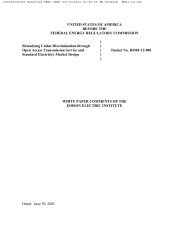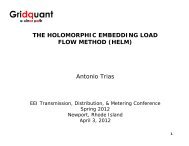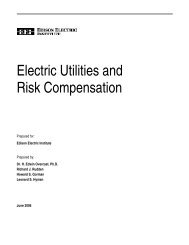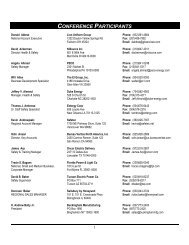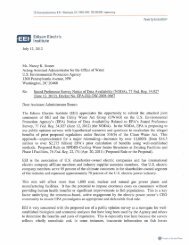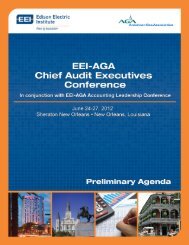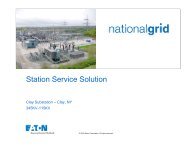Survey Questions - Edison Electric Institute
Survey Questions - Edison Electric Institute
Survey Questions - Edison Electric Institute
You also want an ePaper? Increase the reach of your titles
YUMPU automatically turns print PDFs into web optimized ePapers that Google loves.
Chapter 1: Customer Expectations<br />
Out of Sight, Out of Mind 2012<br />
Historically, consumer expectations and desires have helped guide the development of the electric utility<br />
industry, from its beginning in Thomas <strong>Edison</strong>’s workshop to the vast network of cables and wires that<br />
currently comprise the modern electrical grid. The creation of the electrical grid and the priorities of electric<br />
customers have shaped the development of the industry. Reliability of electrical service, public safety, cost<br />
of service, and electrical system aesthetics have presented challenges and opportunities for electric utilities as<br />
they have sought to balance customer expectations while providing reliable electrical service at a reasonable<br />
price.<br />
As a society, we are more digitally connected today than we could have comprehended 25 years ago. In the<br />
late 1980s, cell phones were big, bulky items that only a few people had and email was just starting to<br />
penetrate the business world as an effective form of communication. Today, most Americans have a cell<br />
phone, a personal computer, and many other handheld electronic devices. The Consumer Electronics<br />
Association notes that, in 2012, the average U.S. household owns 24 consumer electronic devices and this<br />
number has been growing annually. To give a perspective on this growth, the chart in Figure 1.1, Total Sales<br />
of Consumer Electronics, indicates that Americans have spent more than $169,000 million annually on<br />
consumer electronic devices each of the last five years.<br />
Billions<br />
$250<br />
$200<br />
$150<br />
$100<br />
$50<br />
$-‐<br />
Figure 1.1 Total Sales of Consumer Electronics<br />
2008 2009 2010 2011 2012e 2013p<br />
e-estimated, p-projected<br />
Source - Consumer Electronics Association<br />
As the demand for electronic devices has increased, so has the consumer’s sensitivity to electric outages.<br />
These devices provide connectivity to information and communications that Americans expect to use for<br />
business and leisure. When that connectivity is broken, such as during a power outage, there is little<br />
tolerance for any prolonged outage duration.<br />
Because of this sensitivity, an ongoing topic of discussion in the utility-customer relationship is the desire for<br />
a more reliable electric system with fewer outages. Customers tend to think that if the electric system could<br />
be migrated from an overhead to an underground electrical infrastructure, the outage issue would be<br />
resolved. There are merits for making this transition, but there is significant cost involved to make it happen.<br />
In some cases, the desire for undergrounding is driven by utility needs; in other cases, it is a request<br />
<strong>Edison</strong> <strong>Electric</strong> <strong>Institute</strong> 1



